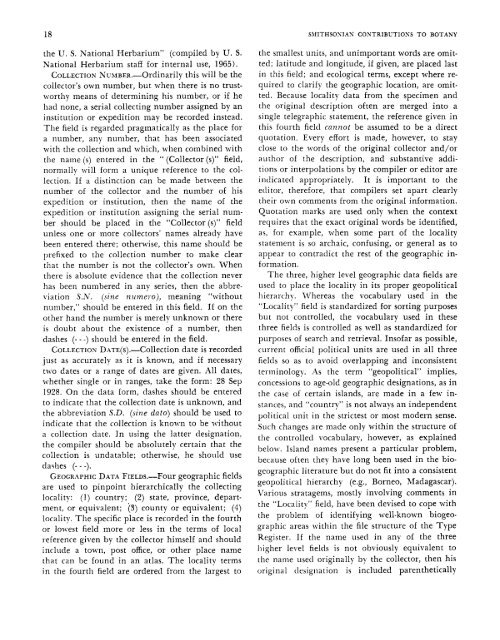An Introduction to the Botanical Type Specimen Register
An Introduction to the Botanical Type Specimen Register
An Introduction to the Botanical Type Specimen Register
Create successful ePaper yourself
Turn your PDF publications into a flip-book with our unique Google optimized e-Paper software.
<strong>the</strong> U. S. National Herbarium” (compiled by U. S.<br />
National Herbarium staff for internal use, 1965).<br />
COLLECTION NuMBER.-ordinarily this will be <strong>the</strong><br />
collec<strong>to</strong>r’s own number, but when <strong>the</strong>re is no trustworthy<br />
means of determining his number, or if he<br />
had none, a serial collecting number assigned by an<br />
institution or expedition may be recorded instead.<br />
The field is regarded pragmatically as <strong>the</strong> place for<br />
a number, any number, that has been associated<br />
with <strong>the</strong> collection and which, when combined with<br />
<strong>the</strong> name (s) entered in <strong>the</strong> “ (Collec<strong>to</strong>r (s)” field,<br />
normally will form a unique reference <strong>to</strong> <strong>the</strong> collection.<br />
If a distinction can be made between <strong>the</strong><br />
number of <strong>the</strong> collec<strong>to</strong>r and <strong>the</strong> number of his<br />
expedition or institution, <strong>the</strong>n <strong>the</strong> name of <strong>the</strong><br />
expedition or institution assigning <strong>the</strong> serial number<br />
should be placed in <strong>the</strong> “Collec<strong>to</strong>r (s)” field<br />
unless one or more collec<strong>to</strong>rs’ names already have<br />
been entered <strong>the</strong>re; o<strong>the</strong>rwise, this name should be<br />
prefixed <strong>to</strong> <strong>the</strong> collection number <strong>to</strong> make clear<br />
that <strong>the</strong> number is not <strong>the</strong> collec<strong>to</strong>r’s own. When<br />
<strong>the</strong>re is absolute evidence that <strong>the</strong> collection never<br />
has been numbered in any series, <strong>the</strong>n <strong>the</strong> abbreviation<br />
S.N. (sine numei-o), meaning “without<br />
number,” should be entered in this field. If on <strong>the</strong><br />
o<strong>the</strong>r hand <strong>the</strong> number is merely unknown or <strong>the</strong>re<br />
is doubt about <strong>the</strong> existence of a number, <strong>the</strong>n<br />
dashes (- - -) should be entered in <strong>the</strong> field.<br />
COLLECTION DATE(S).-collection date is recorded<br />
just as accurately as it is known, and if necessary<br />
two dates or a range of dates are given. All dates,<br />
whe<strong>the</strong>r single or in ranges, take <strong>the</strong> form: 28 Sep<br />
1928. On <strong>the</strong> data form, dashes should be entered<br />
<strong>to</strong> indicate that <strong>the</strong> collection date is unknown, and<br />
<strong>the</strong> abbreviation S.D. (sine da<strong>to</strong>) should be used <strong>to</strong><br />
indicate that <strong>the</strong> collection is known <strong>to</strong> be without<br />
a collection date. In using <strong>the</strong> latter designation,<br />
<strong>the</strong> compiler should be absolutely certain that <strong>the</strong><br />
collection is undatable; o<strong>the</strong>rwise, he should use<br />
da4ies (- - -).<br />
GEOGRAPHIC DATA FIELDS.-Four geographic fields<br />
are used <strong>to</strong> pinpoint hierarchically <strong>the</strong> collecting<br />
locality: (1) country; (2) state, province, department,<br />
or equivalent; (3) county or equivalent; (4)<br />
locality. The specific place is recorded in <strong>the</strong> fourth<br />
or lowest field more or less in <strong>the</strong> terms of local<br />
reference given by <strong>the</strong> collec<strong>to</strong>r himself and should<br />
include a <strong>to</strong>wn, post office, or o<strong>the</strong>r place name<br />
that can be found in an atlas. The locality terms<br />
in <strong>the</strong> fourth field are ordered from <strong>the</strong> largest <strong>to</strong><br />
SMITHSOSIAN CONTRIBUTIOSS TO BOTANY<br />
<strong>the</strong> smallest units, and unimportant words are omit-<br />
ted; latitude and longitude, if given, are placed last<br />
in this field; and ecological terms, except where re-<br />
quired <strong>to</strong> clarify <strong>the</strong> geographic location, are omit-<br />
ted. Because locality data from <strong>the</strong> specimen and<br />
<strong>the</strong> original description often are merged in<strong>to</strong> a<br />
single telegraphic statement, <strong>the</strong> reference given in<br />
this fourth field cannot be assumed <strong>to</strong> be a direct<br />
quotation. Every effort is made, however, <strong>to</strong> stay<br />
close <strong>to</strong> <strong>the</strong> words of <strong>the</strong> original collec<strong>to</strong>r and/or<br />
author of <strong>the</strong> description, and substantive addi-<br />
tions or interpolations by <strong>the</strong> compiler or edi<strong>to</strong>r are<br />
indicated appropriately. It is important <strong>to</strong> <strong>the</strong><br />
etli <strong>to</strong>r, <strong>the</strong>refore, that compilers set apart clearly<br />
<strong>the</strong>ir own comments from <strong>the</strong> original information.<br />
Quotation marks are used only when <strong>the</strong> context<br />
requires that <strong>the</strong> exact original words be identified,<br />
as, for example, when some part of <strong>the</strong> locality<br />
statement is so archaic, confusing, or general as <strong>to</strong><br />
appear <strong>to</strong> contradict <strong>the</strong> rest of <strong>the</strong> geographic in-<br />
formation.<br />
The three, higher level geographic data fields are<br />
used <strong>to</strong> place <strong>the</strong> locality in its proper geopolitical<br />
hierarchy. IVhereas <strong>the</strong> vocabulary used in <strong>the</strong><br />
“Locality” field is standardized for sorting purposes<br />
but not controlled, <strong>the</strong> vocabulary used in <strong>the</strong>se<br />
three fields is controlled as well as standardized for<br />
purposes of search and retrieval. Insofar as possible,<br />
current official political units are used in all three<br />
fields so as <strong>to</strong> avoid overlapping and inconsistent<br />
terminology. As <strong>the</strong> term “geopolitical” implies,<br />
concessions <strong>to</strong> age-old geographic designations, as in<br />
<strong>the</strong> case of certain islands, are made in a few in-<br />
stances, and “country” is not always an independent<br />
political unit in <strong>the</strong> strictest or most modern sense.<br />
Such changes are made only within <strong>the</strong> structure of<br />
<strong>the</strong> controlled vocabulary, however, as explained<br />
below. Island names present a particular problem,<br />
because often <strong>the</strong>y have long been used in <strong>the</strong> bio-<br />
geographic literature but do not fit in<strong>to</strong> a consistent<br />
geopolitical hierarchy (e.g., Borneo, Madagascar).<br />
Various stratagems, mostly involving comments in<br />
<strong>the</strong> “Locality” field, have been devised <strong>to</strong> cope with<br />
<strong>the</strong> problem of identifying well-known biogeo-<br />
graphic areas within <strong>the</strong> file structure of <strong>the</strong> <strong>Type</strong><br />
Kegister. If <strong>the</strong> name used in any of <strong>the</strong> three<br />
higher level fields is not obviously equivalent <strong>to</strong><br />
<strong>the</strong> name used originally by <strong>the</strong> collec<strong>to</strong>r, <strong>the</strong>n his<br />
original designation is included paren<strong>the</strong>tically

















